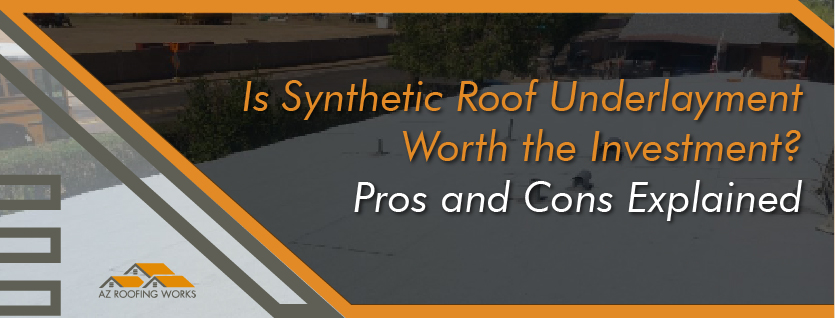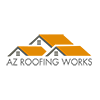Is Synthetic Roof Underlayment Worth the Investment? Pros and Cons Explained
When the skies over Arizona open up to unleash a monsoon fury or the sun blazes down with unforgiving heat, the last thing you want is to worry about your roof giving in.
That’s where synthetic roof underlayment steps in.
It’s a silent protector lying beneath your shingles, guarding your home against the elements.
Synthetic roof underlayment is not just another layer.
It’s your roof’s best defense.
Choosing the right underlayment could mean the difference between a roof that weathers the storm and one that succumbs to it.
This article will explore why synthetic roof underlayment might just be the unsung hero your roof needs.
Keep reading to discover how this critical component can safeguard your sanctuary in the sun-baked or storm-struck landscapes of Arizona.
The Role of Roofing Underlayment
Every house needs a solid foundation, but what about a solid top?
That’s where roofing underlayment comes into play.
Think of it as a hidden hero that sits snugly beneath your roof’s outer layer, tirelessly working to keep your home safe from water damage and enhancing the overall durability of your roof.
This underlayment is essentially a barrier that helps ensure water doesn’t make its way into your home, even when the outer roof materials take a hit from Mother Nature.
In places like Phoenix, Mesa, and Scottsdale, where the weather can swing from scorching heat to sudden storms, the quality of your roofing underlayment is not something to overlook.
It’s the unsung protector against leaks that can lead to costly roof repair down the line.
Pros of Synthetic Roof Underlayment
When we talk about synthetic roof underlayment, we’re looking at the next level of protection for your home.
First off, its durability and longevity are unmatched.
Synthetic materials are engineered to stand up against extreme weather conditions; be it the blistering heat of an Arizona summer or the unpredictable monsoon season.
These underlayments don’t just last longer.
They maintain their integrity, ensuring that your home remains protected year after year.
Moisture protection is another area where synthetic underlayment shines.
Unlike traditional felt materials, which can absorb water and degrade over time, synthetic underlayments repel water.
This is a game-changer during the monsoon season in Arizona, where heavy rains can test the limits of your roof’s moisture barrier.
The superior moisture resistance of synthetic underlayment means a reduced risk of leaks and less worry about water damage to your home’s interior.
Lastly, the ease of installation and safety benefits of synthetic underlayment cannot be overstated.
These materials are generally lighter and more slip-resistant than their traditional counterparts.
It makes the roof installation process quicker and safer for roofers.
This is not just good news for those installing your roof; it’s also good news for you.
Quicker, safer installations often translate to cost savings and less disruption for homeowners.
Plus, the enhanced traction reduces the risk of accidents, ensuring that the professionals working on your roof are as safe as possible.
Cons of Synthetic Roof Underlayment
While synthetic roof underlayment offers several benefits, there are a few drawbacks worth considering.
The first one that comes to mind is the cost.
Synthetic materials are typically more expensive upfront than traditional felt underlayment.
For homeowners on a tight budget, this initial cost difference can be a significant factor in their decision-making process.
It’s important to weigh whether the long-term benefits and durability of synthetic underlayment justify the higher initial investment.
Another consideration is the environmental impact of synthetic materials.
Unlike natural felt, which is made from organic materials, synthetic underlayments are petroleum-based products.
This means they are not as eco-friendly and can take much longer to decompose in landfills.
Homeowners who prioritize environmental sustainability may have reservations about choosing synthetic options for their roofs.
Compatibility issues can also arise with synthetic underlayment.
Certain types of roofing materials or architectural styles may not be well-suited to synthetic products.
For instance, some older or historically styled homes might require specific underlayment types to maintain their aesthetic integrity or functional performance.
In these cases, it’s crucial to consult with professional roofers who can advise on the best underlayment material for your specific roof type and design.
Making the Right Choice for Your Roof
Deciding between synthetic and traditional roof underlayment involves considering several factors unique to your property and preferences.
The climate in Arizona, characterized by its hot summers and occasional intense rainstorms, demands an underlayment that can withstand extreme conditions.
Synthetic underlayment’s superior durability and moisture resistance make it an appealing choice for many homeowners in the region.
However, it’s essential to balance these benefits against the costs and environmental considerations.
The higher initial expense may be offset by the longer lifespan and fewer roof replacement needs over time, but budget constraints cannot be ignored.
Likewise, for those who value eco-friendliness, the search for more sustainable options might lead them to explore advanced eco-friendly synthetic alternatives or stick with traditional materials.
Ultimately, the right choice for your roof will depend on a combination of factors, including your budget, environmental priorities, and the specific requirements of your roofing system.
The goal is to choose an underlayment that offers the best protection for your home, within the parameters of what you value most.
Whether that leads you to a synthetic option or a more traditional material, ensuring your roof is equipped to stand up to the elements is paramount.
Protection at Its Peak
In our exploration of synthetic roof underlayment, we’ve uncovered its unparalleled ability to defend your home against Arizona’s extreme weather.
From bolstering your roof’s defense against water damage to enhancing its longevity, the value of investing in this layer is clear.
AZ Roofing Works stands ready to bring this protection to your home.
Our expertise in high-quality roofing services ensures that your underlayment is installed with precision and care to offer you peace of mind during the harshest weather conditions.
Let AZ Roofing Works fortify your home with the best in synthetic roof underlayment.
Request a free quote today and secure a roof that stands the test of time.
Looking for Ahwatukee roof installers? Look no further than AZ Roofing Works! Contact us today online or call our office directly, our friendly staff members are standing by at (602) 283-3383.






